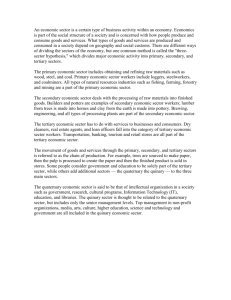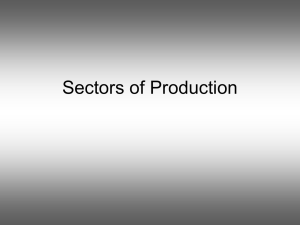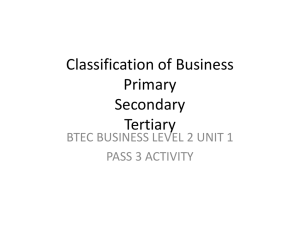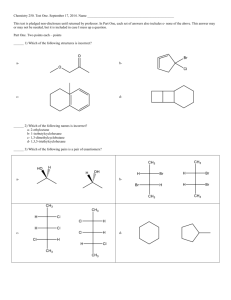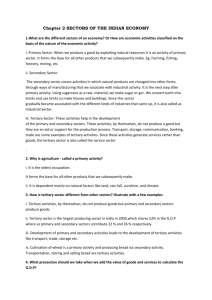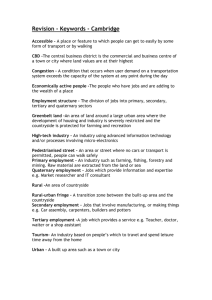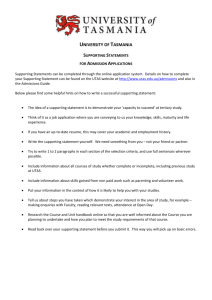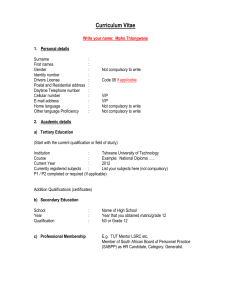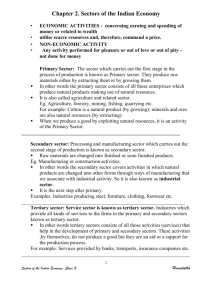Economic Geography: Secondary & Tertiary Sectors
advertisement
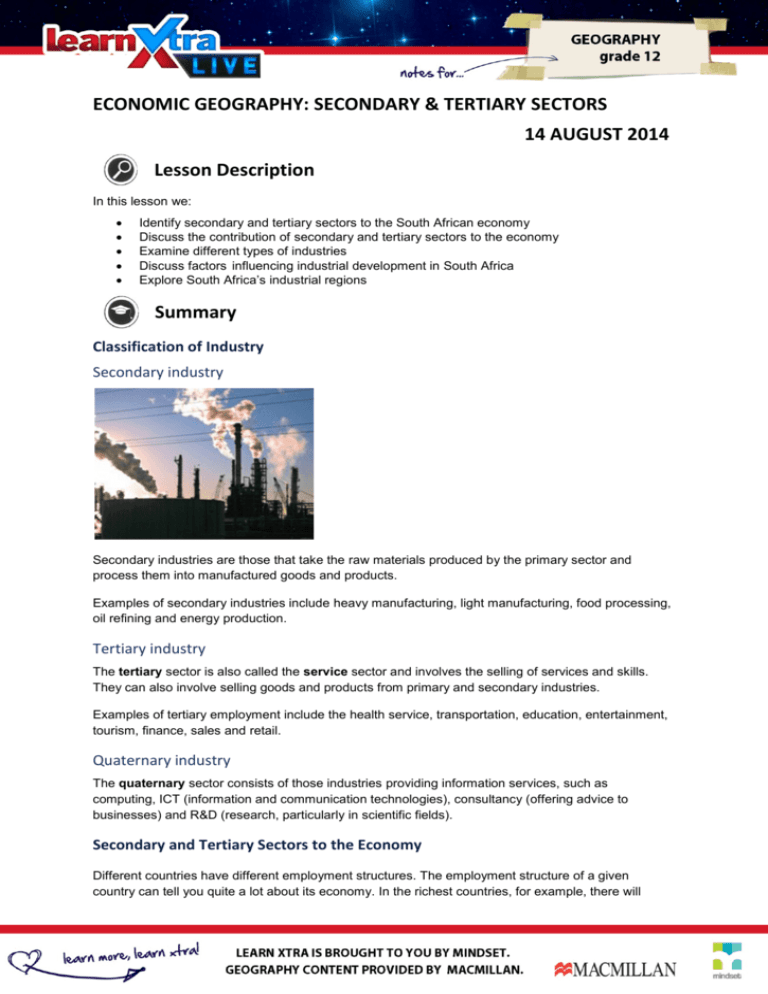
ECONOMIC GEOGRAPHY: SECONDARY & TERTIARY SECTORS 14 AUGUST 2014 Lesson Description In this lesson we: Identify secondary and tertiary sectors to the South African economy Discuss the contribution of secondary and tertiary sectors to the economy Examine different types of industries Discuss factors influencing industrial development in South Africa Explore South Africa’s industrial regions Summary Classification of Industry Secondary industry Secondary industries are those that take the raw materials produced by the primary sector and process them into manufactured goods and products. Examples of secondary industries include heavy manufacturing, light manufacturing, food processing, oil refining and energy production. Tertiary industry The tertiary sector is also called the service sector and involves the selling of services and skills. They can also involve selling goods and products from primary and secondary industries. Examples of tertiary employment include the health service, transportation, education, entertainment, tourism, finance, sales and retail. Quaternary industry The quaternary sector consists of those industries providing information services, such as computing, ICT (information and communication technologies), consultancy (offering advice to businesses) and R&D (research, particularly in scientific fields). Secondary and Tertiary Sectors to the Economy Different countries have different employment structures. The employment structure of a given country can tell you quite a lot about its economy. In the richest countries, for example, there will usually be more people working in the tertiary sector than in the primary and secondary sectors. In the poorest countries, there tend to be more people working in the primary sector than in either the secondary or tertiary sectors. In South Africa the primary sector has traditionally been the largest sector but in the last 30 years the secondary and tertiary sectors have increased. Types of Industry 1. Heavy industry Requires a large quantity of raw materials Usually pollutes Bulky end products Uses heavy machinery 2. Light industry Requires a large market and access to customers Light weight raw materials Uses light machinery Small end product Factors influencing the location of industries: The location of industry depends on what is being produced 1. Physical Factors: Heavy industry needs to be near raw materials such as coal, iron ore and electricity. These industries also need mass transport like railways and water transport. 2. Economic Factors: Certain industries need to be near their markets, e.g. service industries. Certain activities also require large amounts of capital input and are near large markets. 3. Social Factors: Each manufacturing activity requires different amounts of labour, both in terms of quantity and skill levels. For example, a mine requires large numbers of miners but they need not be very skilled. A finance house may only require few personnel but they would be highly skilled. 4. Political Factors: The government may decide where to establish industries (e.g. Coega). Factors Favouring and Hindering Industrial Development in Various Regions Traditionally South Africa has four manufacturing regions, namely the PWV complex of Gauteng, the Durban-Pinetown region, the South-western Cape region and the Port Elizabeth-Uitenhage region. Region PretoriaWitwatersrandVaal complex (PWV) Main Industries Reasons for development Metal, iron and steel, machinery, chemicals, transport, equipment. DurbanSugar, chemicals, Pinetownpaint, textiles, Pietermaritzberg shipping Region South-western Cape Region Wine, fresh fruit packing, dried fruit, canning, fish, clothing, food. Port ElizabethUitenhage Region Motor vehicle assembly plants, motor vehicle parts. Discovery of gold. Good agricultural land. Fast growing population provided market. Availability of various raw materials Water available. Good transport network linked to ports. Huge capital available Port location High population concentration with skilled and unskilled labour Availability of resources as well as imports High rainfall for good water supply Energy – availability of coal Suitable relief Market availability Historical lead as first Western-type city Tradition of specialised manufacturing skills Inland dams provide adequate water Education above national average. Important harbour, also fast rail and road links. Large local market and foreign tourists. More than adequate water Centrally located modern harbour Equalised rail tariffs Large labour pool Coega project is large new industrial development zone near PE. Limitations Water will become scarce Housing and social necessities no longer adequate Far from harbour Harbour developed to capacity Hilly topography limits space Not any local power course Few natural minerals Dry summers with limited water supply Buying power lower than PWV complex Far from main consumer areas Labour costs higher than Asia and Eastern Europe for car production Labour unrest and strikes. Test Yourself Question 1 The provision of electricity is a … activity. A primary B secondary C tertiary D quaternary Question 2 The sector of the economy that is not regulated and registered for taxes is the ... sector. A formal B tertiary C informal D primary Question 3 The clustering of economic activities that are similar and rely on each other is referred to as … A agglomeration B centralisation C decentralisation D nationalisation Question 4 Which ONE of the following economic activities is associated with the tertiary sector? A Mining B Forestry C Retail D Agriculture Question 5 Industries that are service-orientated are known as … industries. A market-orientated B raw materials orientated C footloose D bridge Improve your Skills Question 1 1.1 Define the following concepts and give an example of each one: 1.1.1 Heavy industry 1.1.2 Light industry 1.2 What is an ubiquitous industry? 1.3 Give an example of a footloose industry Question 2 Look at the map below and answer the questions that follow 2.1 Identify the industrial areas marked A, B, C and D respectively. 2.2 Provide TWO factors that promote industry at A. 2.3 State the main type of industry found at B. 2.4 What is a break-of-bulk point? Give examples that take place in region A and B 2.4 Briefly discuss any TWO factors that promoted industrial development in South Africa. 2.5 Briefly discuss any TWO factors that are currently restricting industrial development in South Africa. Question 3 Refer to the following figure in order to answer the following questions. 3.1 Which economic activity contributed the highest percentage to the GDP? 3.2 What percentage contribution do the secondary and tertiary sectors make to GDP? 3.3 Explain why the secondary and tertiary sectors are increasing in the South African Economy Links South African Water Game Challenge 2014: http://www.watergame.co.za/

